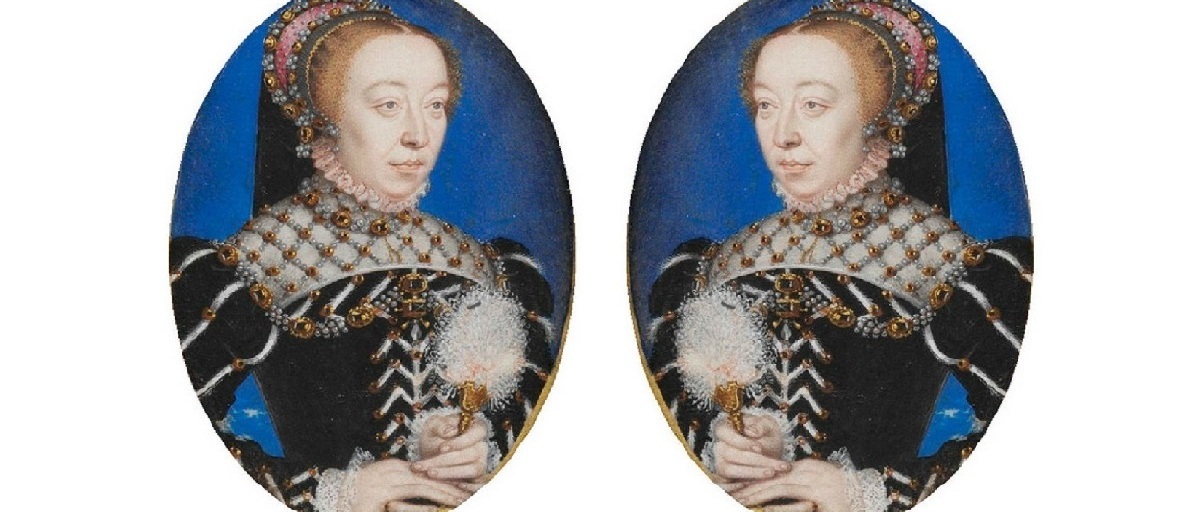Catherine de' Medici
Posted on 20th January 2021
Caterina Maria Romula di Lorenzo de’ Medici was born on 13 April 1519 in Florence, Italy, the only child of Lorenzo II de’ Medici, Duke of Urbino and Madeleine de la Tour d’ Auvergne.
Within one month of Catherine’s birth, both her parents were dead, and Pope Leo X took charge of her care. She was first placed in the care of her paternal grandmother Alfonsina Orsini, and then in the care of her aunt Clarice Strozzi, and finally following Pope Leo’s death, Pope Clement VII placed her in the Palazzo Medici Ricardi in Florence to live in state.
The Medici were overthrown in Florence in 1527 and Catherine was taken hostage and placed in a series of convents. Following the retaking of the city in 1530, Catherine was summoned to attend Rome by Pope Clement.
It was now time for the Pope to find Catherine a husband, and many would vie for her hand in marriage, but Pope Clement chose Henry, Duke of Orleans, second son of Francis I of France.
Henry and Catherine were married on 28 October 1533 in the Eglise Saint-Ferreol les Augustins in Marseille, France.
It would take many years for Catherine to produce an heir, and during the early years of her marriage Henry started an affair with Diane de Poitiers, among others. This affair was to last many years and Poitiers held much influence over Henry during this time.
Catherine was under pressure to produce an heir, and following the death of Henrys older brother Francis in 1536, this pressure increased as Henry was now heir to the French throne.
Catherine finally gave birth to a son Francis on 19 January 1544 after ten years of marriage. She now had no trouble conceiving again and her marriage to Henry would produce ten children with seven surviving infancy including three future Kings of France, Francis II, Charles IX and Henry III.
Henry came to the throne of France, following his father King Francis Is death in March 1547. Catherine was now Queen consort and she was crowned on 10 June 1549 in the Basilica of Saint-Denis in France.
In April 1559 Henry signed the Peace of Cateau-Cambresis with the Holy Roman Empire and England. As part of the treaty, Catherine’s daughter Elisabeth was betrothed to Philip II of Spain, and they married by proxy on 22 June 1559 in Paris, France.
During the wedding festivities, Henry took part in jousting and was injured by Gabriel, Comte de Montgomery. He later died from his injuries on 10 July 1559.
Catherine and Henrys fifteen year-old son Francis, now became Francis II of France. Although he was considered of an age where he could rule by himself, charge of the government was taken by the Guise family, relatives of young Francis’ wife Mary, Queen of Scots.
This rule was not to last long as Francis died within a year. Catherine’s ten year-old son Charles now came to the throne as Charles IX and due to his young age Catherine acted as regent.
During the reign of Francis, the Catholic Guise family had set about persecuting the protestant Huguenots, however Catherine believed more in reconciliation between the opposing sides.
She arranged a religious conference, the ‘Colloquy of Poissy’ in 1561 between the Catholics and Huguenots. This was followed by the ‘Edict of Saint-Germain, but they both failed.
On 1 March 1562, the ‘Massacre of Vassy’ took place where the Catholic Duke of Guise attacked worshipping Huguenots, killing over seventy people and injuring many more. This was the spark that ignited the French Wars of Religion, which would last for over thirty years.
The Peace Treaty of St Germaine was signed in 1570 and an agreement was made to the marriage of Catherine’s daughter Margaret to the protestant Henry III of Navarre, which took place in 1572.
During the marriage celebrations, the Huguenot leader Admiral Coligny was shot and injured. This led to the St Bartholomew’s Day massacre, in which Catholics slaughtered prominent Huguenots attending the wedding. The slaughter spread throughout France with thousands dying. Many believe Catherine was responsible for the slaughter, and her reputation would barely if ever recover from these allegations.
In 1574 Catherine saw the second of her sons, Charles IX die while on the throne of France; now her son Henry came to the throne as Henry III of France. Although Henry was an adult he still relied on his mother for advice, although he was not as easily manipulated as his brothers.
Henry IIIs marriage did not produce any heirs, and his younger brother Francis died in 1584 putting the Catholic reign of France into jeopardy. Catherine now relied more on the prominent Catholic Guise family, but against her wishes, Henry ordered the execution of the Duke of Guise and other prominent members of the family. Now the protestant Henry III of Navarre was heir to the throne of France.
Catherine continued for the remainder of her life to reconcile the opposing sides of Catholic and Huguenot Protestants, but with little success. She spent her time travelling around the French provinces garnering support for the Catholic cause.
Catherine died on 5 January 1589, and is buried in the Basilica of Saint-Denis in Paris.
Her son Henry III was assassinated less than a year later and Henry III of Navarre became Henry IV of France.
Tagged as: Junior Tudors
Share this post:





